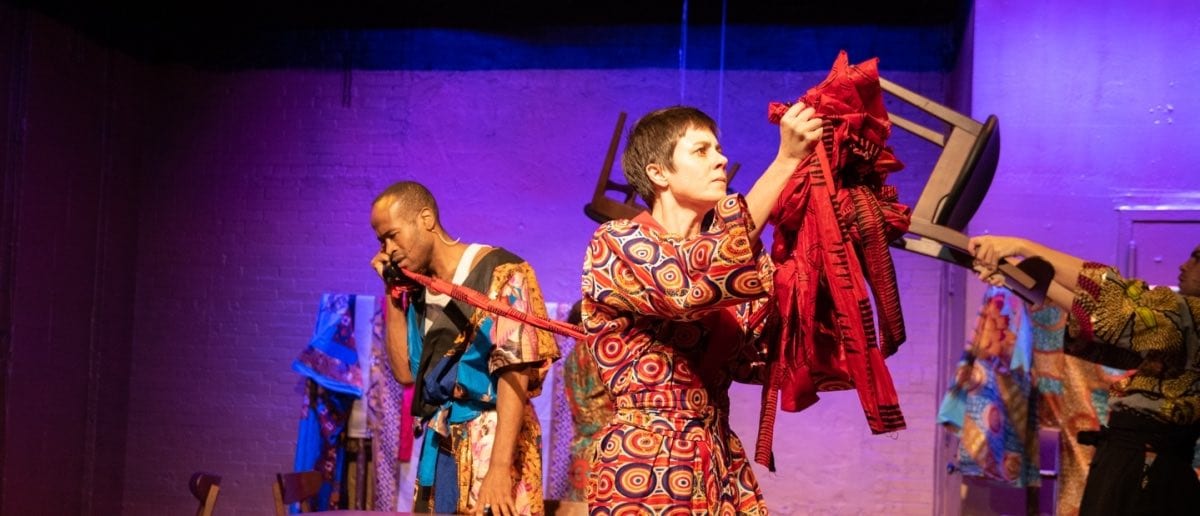The most memorable line from Sara and Reid Farrington’s BrandoCapote was an analogy that likened three middle-school bullies to a “Cerberus of averageness.” I don’t think that’s what I was supposed to take away from a work about Marlon Brando (Rafael Jordan), brought to life through clips from his most notable movies and an “interview” by Truman Capote/the Devil (Jennifer McClinton) a la Capote’s 1957 New Yorker profile on the actor, meant to “expose generations of toxic masculinity, abuse and violence, while exorcising the demons of American celebrity.” But alas, here I am, unclear about most of what I watched for an hour, but vividly stuck on how darn accurate of a metaphor that is for adolescent boys.
In an attempt to provide you more clarity than I had, let me return to that sentence about the plot – there’s a lot to unpack there. The show opens with Brando’s highlights reel projected on a rainbow-colored screen (imagine the garish stripes that appear on your TV when the cable isn’t working), treating us to classic clips from On the Waterfront, A Streetcar Named Desire and The Godfather, to name a few. It’s quite an enjoyable intro – I felt like I was back in the intimate independent movie theater in my hometown, and the walk through Brando’s film history only added to the sense of warm nostalgia. Eventually, a Japanese woman comes onscreen and tells the audience they’re about to see some scenes from another Brando flick, Sayonara. The screen promptly falls to reveal a hotel room in Kyoto’s Miyako Hotel (the on-location site where Capote met Brando for his New Yorker interview), which kind of looks like a textile factory due to the way the actors repetitively unfurl and gather long strips of cloth, but which is also supposed to be purgatory? And so the murkiness begins.
McClinton, as the journalist, interviews Brando about his life, meant to evoke the famous profile, “The Duke in his Domain.” One point of interest is how his son, Christian, murdered his daughter, Cheyenne’s, boyfriend, a real-life event meant to parallel the themes of Capote’s famous work, In Cold Blood. None of those names or titles are mentioned at any point, live or offstage (many lines are mimed by the characters as a disembodied voice delivers them over the Tank’s speakers). The timeline of events included in the program makes this a little more apparent. How the whole thing exorcised demons of American celebrity or exposed generations of toxic masculinity, abuse and violence, though, I cannot say, but for one harrowing moment in which Cheyenne (Laura K. Nicoll) tries to escape the scene, only to be stopped by red cloth and Brando, who covers her mouth and drags her offstage as she screams.
That (ironically) brings me to my most positive commentary: I may not have understood all I was watching, but BrandoCapote is gripping to watch (save for a few prolonged sequences of slow, drawn-out walking around the stage). The action repeatedly freezes to showcase a clip from a Brando movie, projected perfectly onto white parasols and fans. Besides the film intervals, the show is a dance theatre piece – the actors ground themselves in sharp, synchronized yet chaotic movements, all washed in colorful light. And the performers, of course, lean fully into every motion and emotion, from the way they shudder in time with the rhythmic din of TV static in the opening scene, to Nicoll’s fright as Cheyenne and McClinton’s sheer thrill when characters begin to argue or fight (this can be attributed to her role as the Devil or as the journalist who lives for a good story; I choose to promote the latter).
Its visual excellence, however, doesn’t quite pardon the alienating way the plot is told – BrandoCapote simply tries to thread together too many narratives at once, and none of them emerge the lead. It almost achieves the opposite of its intended effect; the sentimentality (intended or not) of the opening film sequence stuck with me more than whatever grave themes about toxic celebrity it tried to assert. So you can probably achieve a similar effect by reading Capote’s article and following it with a Brando movie marathon: learning the flaws of the actor, but enjoying his repertoire nonetheless.

